According to McKinsey, companies that have enterprise agility share some commonalities: a North Star-mentality, in other words an overarching customer strategy; a scalable team structure; a rapid decision-making mentality; a dynamic people model that ignites passion; and a willing adoption of next-generation technologies.
In today’s environment, one in which companies find themselves having to transition from old business models dependent upon traditional organizational modes of operation based on an industrial economy to a model more suited for a digital 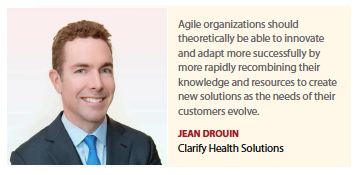 economy, organizations will be required to be agile. McKinsey experts say this paradigm shift requires a new form of organization that enables innovation, collaboration, and value creation at an unprecedented speed, scale, and impact. They say agile organizations can develop products five times faster, make decisions three times faster, and reallocate resources adroitly and quickly. Further, those companies making the transition successfully are achieving substantive performance and health improvements: enhanced growth, profitability, customer satisfaction, and employee engagement. More than any other factor, the key to a successful agile transformation is for leaders, particularly senior leaders, to develop substantially new mindsets and capabilities.
economy, organizations will be required to be agile. McKinsey experts say this paradigm shift requires a new form of organization that enables innovation, collaboration, and value creation at an unprecedented speed, scale, and impact. They say agile organizations can develop products five times faster, make decisions three times faster, and reallocate resources adroitly and quickly. Further, those companies making the transition successfully are achieving substantive performance and health improvements: enhanced growth, profitability, customer satisfaction, and employee engagement. More than any other factor, the key to a successful agile transformation is for leaders, particularly senior leaders, to develop substantially new mindsets and capabilities.
In a recent Forrester report, commissioned by Cognizant (see the Executive Perspective in this issue for more information) analysts determined that digital transformation is a requirement to keep up with today’s consumers and win in any industry. However, investments being made today too often focus on the front-end experience or on other parallel but separate initiatives to transform the front- and back-end experience. Successful digital transformation requires transforming the entire enterprise and requires a cohesive and tightly fused approach across functions.
The Forrester survey found that companies with higher digital maturity are 2.5 times more likely to report double-digit revenue growth; fewer than 40% of companies have aligned internal teams to put the customer at the forefront of their activities; back-end process teams (e.g., supply chain, finance) are the least likely to have a decision-making role in digital transformation; and digital transformation maturity is driven by four key areas: process, organization, technology, and data insights.
McKinsey analysts say companies that have enterprise agility share some 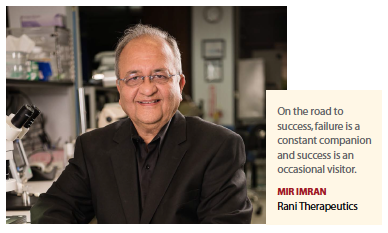 commonalities: a North Star-mentality, in other words an overarching customer strategy; a scalable team structure; a rapid decision-making mentality; a dynamic people model that ignites passion; and adoption of next-generation technologies.
commonalities: a North Star-mentality, in other words an overarching customer strategy; a scalable team structure; a rapid decision-making mentality; a dynamic people model that ignites passion; and adoption of next-generation technologies.
For this special cover story, PharmaVOICE asked executives from a variety of different companies in the life-sciences industry to assess their agile readiness and provide input on how market factors are impacting their strategies, what their North Star is in terms of focus, how they are creating scalable teams, how ready they are to make rapid decisions, their people models, and the impact technology is having on their operations.
The majority of respondents to our survey indicated that they were trending to the agile model, with nearly 70% of executives rating their organizations as midway to all the way agile.
~~~~~~~~~~~~~~~~~~~~~~~~~
The Market Environment
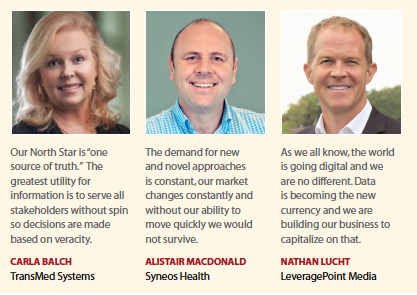 We asked our experts to discuss the extent to which their organization’s market environment is putting pressure on their organization to become more agile.
We asked our experts to discuss the extent to which their organization’s market environment is putting pressure on their organization to become more agile.
Joe Depinto
Cardinal Health Specialty Solutions
The healthcare marketplace we work in is evolving quickly. There are many factors in play, including policy, price, access to medications, and technology innovation requiring organizations to problem solve for their customers more than ever.
Alistair MacDonald
Syneos Health
The demand for new and novel approaches is constant, our market changes constantly and without our ability to move quickly we would not survive.
Julie Ross
Advanced Clinical
As a CRO we must be agile to effectively serve our customers and stay ahead of the competition. The clinical research industry is undergoing rapid change driven by AI, machine learning, blockchain, wearables, and virtual trials enabled by newer technology, all of which mandate agility.
Carla Balch
TransMed Systems
Recent advances in the utility of real-world data for drug approval processes, including clinical trial matching, make this a rapidly developing environment that plays to our company’s inherent strengths.
Mir Imran
Rani Therapeutics
Questions around agility and market pressure are appropriate to organizations that are large, stodgy, slow, and indecisive. These organizations don’t take risks. Executives 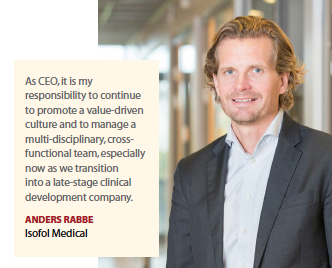 in those type of companies often make decisions that are in their own personal best interest — small successes that are attributable to them. But executives should have a long-term view — making good decisions that will have a long-term impact, even if that means that there is no short term, personal gain. Agility should be a requirement of all companies, and if companies and their executives are not agile and making swift and important decisions to advance the cause, that sets the tone for the entire company and everyone suffers as a result.
in those type of companies often make decisions that are in their own personal best interest — small successes that are attributable to them. But executives should have a long-term view — making good decisions that will have a long-term impact, even if that means that there is no short term, personal gain. Agility should be a requirement of all companies, and if companies and their executives are not agile and making swift and important decisions to advance the cause, that sets the tone for the entire company and everyone suffers as a result.
Jim Weiss
W2O
As a communications, marketing, and digital consulting firm, we must be ahead of the curve due to the realities of radically changing consumer expectations and behavioral patterns. First is our ability to stay nimble and pivot is critical. Second, dealing with the healthcare market, we must be adept at shifting value propositions regarding access, digital health information, consumer power, and pricing, not to mention an increasing array of industry regulations.
Nathan Lucht
LeveragePoint Media
Rapidly changing technologies and sources of data necessitate companies like ours to be fast and nimble. As new data sets, such as geo-location, become more accurate and can be combined with other contextual data sets it provides marketers with new ways 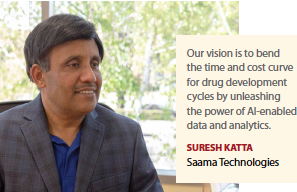 to more precisely reach their target consumers. We must be able to bring these cutting-edge capabilities to our clients in a data secure and brand safe way.
to more precisely reach their target consumers. We must be able to bring these cutting-edge capabilities to our clients in a data secure and brand safe way.
Sherri Wilkins
Carling Communications
The market absolutely demands that we continue to make our organizational structures more sophisticated. It’s way more than a clever campaign slogan and a business development plan these days. Leaders have to show that their teams are empowered to make decisions and create efficiencies; today’s clients want to feel confident that we can grow with them and that it’s not just a few select execs who understand their business objectives. Empowering middle and senior managers to make business decisions is crucial to reinforcing an agency’s agility and our ability to scale, while also engaging employees in ways that keep them interested and gratified.
Sonja Foster-Storch
Syneos Health Communications
It is an exciting time to be in healthcare communications — creative and technology are closer than ever, lives are changing, and health is improving for patients worldwide. It also means that client needs are evolving at a very rapid pace and we need to be more versatile than ever. It’s imperative that we continue to find talent who are versatile, have a depth of experience, understand needs, and can deliver a diverse set of solutions.
Mike Nolte
CRF Bracket
In today’s fast-changing world, companies that prosper must respond to both changing customer needs and competitor challenges. Industry structure, cultural history, and a complex regulatory environment create unique challenges, but excite us as innovators. We want to move urgently in a test-and-learn environment where people are encouraged to make decisions, take chances, and learn from their mistakes. That is where growth and transformation stem from in any agile organization.
Joan Bradley
JB Ashtin
Our clients’ businesses are rapidly becoming more agile, which in turn, is requiring our team to be more agile. Although we have always thought of ourselves as an agile service provider that works swiftly to meet customer needs, we are guilty of sometimes having too much infrastructure, even for a small company. Related to the McKinsey definition of agile — we’re getting there as a company. Being a privately owned small company allows us to be nimble and flexible so we can evaluate what is/isn’t working and quickly adjust and move on.
Dr. Michael Bozik
Knopp Biosciences
The dynamic interaction of market forces demands high agility even of a pre-revenue 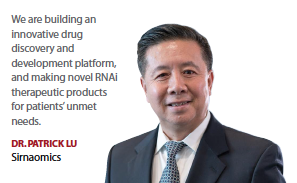 biotechnology company such as ours. We must continually assess financial markets, product markets, regulatory environments, biomedical innovation — both domestically and internationally — and how these forces bear on our platform priorities as well as on our potential collaborators and customers.
biotechnology company such as ours. We must continually assess financial markets, product markets, regulatory environments, biomedical innovation — both domestically and internationally — and how these forces bear on our platform priorities as well as on our potential collaborators and customers.
Alex Huang
Quellthera
As a company with a core mission to develop new therapeutic paradigms to address the global antibiotic resistance crisis, we find ourselves at the forefront of a rapidly evolving understanding of bacteriology and the microbiome, demanding our ability to incorporate and adapt to emerging science, yet vulnerable to the lagging response in the business models of large pharma companies. Their recent abandonment of obsolete and economically unattractive antibiotic and vaccine programs is driven by a continuing trend for exceptionally high drug pricing for orphan and oncologic drugs.
This fosters an industry mentality that is counter to investment in innovative public health solutions that would be relevant outside the unique U.S. payer ecosystem.
Extreme agility is a fundamental requirement in developing, evangelizing, and seeking funding for long-term sustainable technologies that can be broadly accessible outside the United States and must at the same time overcome the perception of limited economic value.
Jean Drouin
Clarify Health Solutions
As we head into an increasingly uncertain economic and regulatory environment over the next decade, where an aging and rightfully demanding public increases the pressure to deliver value, innovation, speed to market, adaptability, and the ability to delight the customer will be paramount. Agile organizations should theoretically be able to innovate and adapt more successfully by more rapidly recombining their knowledge and resources to create new solutions as the needs of their customers evolve. However, beware of latest management fad vs. on-the-ground reality. Success in deploying agile ways of working requires managing the tension between execution, which traditionally has required focus on a few priorities typically selected in an annual planning cycle, and rapid learning that requires an openness to changing priorities on shorter time cycles. It’s all too possible to swing the pendulum too 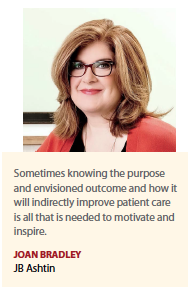 abruptly and end up with a litany of innovative, yet incomplete and delayed initiatives. The winners will be those organizations that continue to deliver solutions that address the unmet needs of their customers better than the competition. Agile execution, rather than agile in and of itself, will be the key to success.
abruptly and end up with a litany of innovative, yet incomplete and delayed initiatives. The winners will be those organizations that continue to deliver solutions that address the unmet needs of their customers better than the competition. Agile execution, rather than agile in and of itself, will be the key to success.
Daljit Cheema
Pharmaseal
Developing the next generation of software products that focus on customer-centricity, frequent innovations at Internet scale requires us to re-invent traditional software engineering practices and adopt innovative agile engineering models and harness the best that cloud computing offers.
Patrick Hughes
CluePoints
The areas of risk-based monitoring and risk-based quality management are both evolving and emerging respectively and we have to adapt solutions based on the progress of the pharmaceutical industry down the path of adoption, particularly due to the advent of opportunities and challenges within ICH E6 R2. These shifts in paradigm and working practices generate new ideas and requirements both through internal innovation and with external inputs from across the industry. A traditional approach to developing software solutions would not enable us to address these dynamic business areas effectively and so we have to be an agile organization to best offer industry solutions in these areas.
~~~~~~~~~~~~~~~~~~~~~~~~~
North Star
According to McKinsey, agile organizations reimagine both whom they create value for, and how they do so. These organizations are intensely customer-focused, and seek to meet diverse needs across the entire customer life cycle. Further, they are committed to creating value with and for a wide range of stakeholders (for example, employees, investors, partners, and communities).
To meet the continually evolving needs of all their stakeholders, agile organizations design distributed, flexible approaches to creating value, frequently integrating external partners directly into the value creation system.
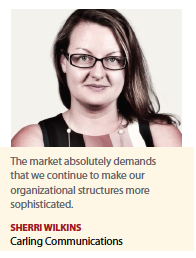 To give coherence and focus to their distributed value creation models, C-suite executives of agile organizations set a shared purpose and vision — the North Star — for their companies that helps people feel personally and emotionally invested.
To give coherence and focus to their distributed value creation models, C-suite executives of agile organizations set a shared purpose and vision — the North Star — for their companies that helps people feel personally and emotionally invested.
This North Star serves as a reference when customers choose where to buy, employees decide where to work, and partners decide where to engage. We asked our field of experts to describe their company’s North Star.
Daljit Cheema
Pharmaseal
We firmly embed customer-centricity, continuous innovation, and empowerment at the heart of our culture.
Suresh Katta
Saama Technologies
Our vision is to bend the time and cost curve for drug development cycles by unleashing the power of AI-enabled data and analytics.
Dr. Michael Bozik
Knopp Biosciences
Meeting patient needs is our sine qua non. It creates culture, drives strategy, defines tactics, and promotes agility.
Alistair MacDonald
Syneos Health
Taking therapies to patients as quickly and efficiently as we can is our True North. Not just developing a treatment, but making sure people can access it as it’s positioned properly in the market with access.
Carla Balch
TransMed Systems
Our North Star is “one source of truth." The greatest utility for information is to serve all stakeholders without spin so decisions are made based on veracity. The truth is the truth and should be available to every patient, scientist, physician, and healthcare executive.
Jim Weiss
W2O
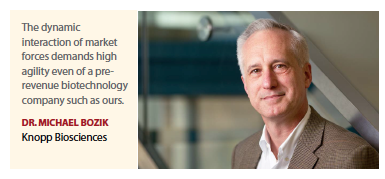 We are in the business of making the world a healthier place through marketing communications that connects people, knowledge, and care. We do this by being the best at what we do.
We are in the business of making the world a healthier place through marketing communications that connects people, knowledge, and care. We do this by being the best at what we do.
Sonja Foster-Storch
Syneos Health Communications
Our “speak people" philosophy — to change the conversation in healthcare by humanizing health communications — is guiding us forward to meet the ever-changing needs of our diverse healthcare customers. It is what connects us as an agency by giving meaning to what we do each and every day.
Mike Nolte
CRF Bracket
There’s a reason why most people choose to work in the life sciences, and that is to be part of a process that improves lives for our own families and our communities around the world. We believe technology can make these improvements happen faster and better than ever before. By focusing on what matters, which is knowing our customers and ensuring their success in their mission, a patient-centric approach can manifest itself today in better efficiency, speed, and quality for clinical trials. Tomorrow that will mean moving on from traditional sites, to new ideas of service for communities and families around the world. We are guided to making these aspirations a reality as our customers fundamentally change how clinical research is conducted.
Joan Bradley
JB Ashtin
By focusing on the metric of repeat and continued business with our clients that we worked so hard to get, everything else — service, quality, revenue, referrals, client/employee satisfaction — falls into place.
Dr. Patrick Lu
Sirnaomics
We focus on innovation, global vision, and patient-centricity. At the present stage of the company, current and potential partners are our customer base. We are focusing on shaping our RNAi therapeutic product pipeline to meet their interests. For example, the industry is paying great attention to immune oncology (I-O), and we have committed our R&D resources to I-O-related product development.
Patrick Hughes
CluePoints
Our North Star is to be the provider of enabling technologies for ICH E6 R2 compliance, risk-based monitoring, and overall data quality oversight within clinical trials.
Alex Huang
Quellthera
Our ultimate mission, regardless of the tactical choices we must make to succeed, is to develop an accessible and long-term viable alternative paradigm that will sufficiently displace the global use of antibiotics to meaningfully reduce the threat of a drug-proof infectious pandemic, and to enable mainstream stewardship that assures the continuing efficacy of antibiotics for future generations.
Empowered Teams
Agile organizations maintain a stable backbone structure and work through a network of small, empowered teams. They are also replacing much of the remaining traditional hierarchy with a flexible, scalable network of teams. We asked our experts to explain the advantages of having a network of small, empowered teams, to detail what their biggest workforce challenge are today, and where their biggest talent gaps are.
Alexis Peyroles
OSE Immunotherapeutics
There are several advantages to leveraging small teams empowered with the ability to work independently or semi-independently from our centralized corporate structure.
First, empowering teams to act independently streamlines the decision-making process, especially in situations where either timing is key or where the decision does not affect the whole organization. Another benefit of empowering smaller independent teams is that it signals to employees that their ideas are valuable, resulting in team members being more vocal with their ideas. Using a team-based organizational structure also allows us to efficiently parcel out large projects and to ensure that resources are allocated easily and efficiently. The most notable disadvantage is the difficulty of maintaining open communication channels between teams. As the number of teams or the autonomy given to each increases, so does the need to have everyone on the same page. Modern communications tools certainly help, but additional oversight is often necessary to make sure that everything runs smoothly.
Mike Nolte
CRF Bracket
The agile model calls for autonomous, self-directed, highly motivated teams who know their subject matter well and can make decisions quickly. To start, we need to build a consistent and compelling culture, recruit and retain great people, and ensure all our teammates understand the strategy and service commitment we’ve made with our customers. As a leader, I will always be accused of sharing too much over too little. I think this kind of honesty about what’s going on behind the scenes — both the good and the bad — builds trust and a shared enthusiasm to improve our work consistently. We want everyone to be active decision makers, be collaborative in their work, and be enabled to control their environment and outcomes. This takes great communication linked to clear goals at all times. In short, we want everyone to wake up every day thinking about how we can honor our commitments to help our customers bring new treatments to market faster — and to be excited to be a part of that journey. Networks of small, empowered teams that can work collaboratively on a problem and control investment, customer outcomes, and their own work environment, are more enthusiastic, engaged and view the work they do as more meaningful. We can’t afford half efforts or just to have a few star performers carrying most of the work. Everyone must have an equal desire to fully engage and take an equal share of work and success.
Suresh Katta
Saama Technologies
Empowered teams promote creativity and decentralize innovation, which we have termed internally as “disorganized innovation." However, this does not constitute a “wild west" mentality. Disorganized innovation is contextualized with our broader vision and strategic product and service offering goals. I can’t visibly think of any disadvantage. If the small teams are not empowered with a vision and purpose, that could be the single biggest contributing factor for unsuccessful teams. Data science is a highly specialized skill set that is in high demand in Silicon Valley. There is a lot of competition with other larger companies to attract talent. Pharmaceutical companies will continue to face a competitive talent landscape, so they will have to be creative in how to attract this skill set.
~~~~~~~~~~~~~~~~~~~~~~~~~
Rapid Decision and Learning Cycles
Agile organizations work in rapid cycles of thinking and doing, breaking work down into small packages; executing in short, focused bursts; and frequently recalibrating based on carefully tracked goals and metrics. We asked our thought leaders if their organizations are structured for working in rapid cycles of thinking and doing.
Daljit Cheema
Pharmaseal
Product management and engineering operate as a single entity with transparent communications and an empowered team. We started the business with agility at the core of the company. We operate two weekly product development cycles where we develop, test, review and accept software features as well as plan for the next set of cycles and review the cycle just completed. This gives us the ability to react quickly to feedback during the product development cycles we operate and lets us adapt and incorporate new ideas quickly.
Alex Huang
Quellthera
We have a very collaborative extended board structure that engages finance, operations, R&D, legal, and strategy in a highly communicative manner to keep all parties remotely synchronized both verbally and in writing with a minimal number of formal physical meetings. Well-defined ongoing process of legal review/ opinion on matters in support of a non-hierarchal discussions are recorded but formalized in document only as needed.
Alistair MacDonald
Syneos Health
We have a flat organization where working in teams across levels is encouraged. Collapsing the hierarchy enables rapid, empowered decision-making.
Carla Balch
TransMed Systems
We use a well-oiled machine of stage/date decision making for any product or service candidate. Any member of the team can propose a product or service idea by spinning up a small work team that is experienced in the core topic. This team thoughtfully 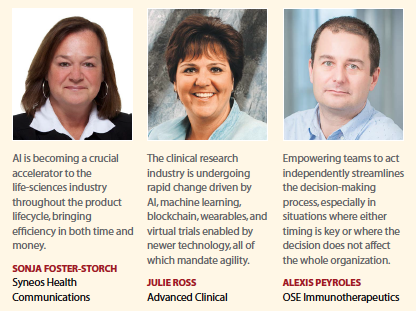 engages to submit a stage/gate proposal to the leadership circle, which discusses weekly and promotes product or service candidates to the appropriate roadmap to be slotted for development. We are agile and fast — we have to be to excel in the rapidly evolving healthcare market.
engages to submit a stage/gate proposal to the leadership circle, which discusses weekly and promotes product or service candidates to the appropriate roadmap to be slotted for development. We are agile and fast — we have to be to excel in the rapidly evolving healthcare market.
Jim Weiss
W2O
We have closed the bubble in terms of the number of people involved, limiting decisions to the right voices. An example is how we now determine where new offices should be opened. The process includes CEO, president, CFO, and facilities head vs. including our operating company heads and shared services leads. We have always worked as one P&L so it’s all for one and one for all (#OneTeamOneDream). We take a best-teams approach with each and every assignment.
Mike Nolte
CRF Bracket
Agile adoption was compelling because technology companies sought to reduce re-work and shorten development cycle times. Traditionally, they would spend months developing a software product, introduce errors along the way, work to eliminate quality issues, and — ideally — finally finish with a marketable product. However, during that long development cycle, there was risk of the market changing, the product coming together wrong, etc. As a technology company, we fully appreciate agile as a foundation of what we do. Yet, in my experience, agile is just a tool, with the real goal of using cycle times as a critical measure for executing any process with high quality. Our goal is to rationalize where and how we use concepts like agile. For example, when we decide to implement a new business system, we often run a pilot where we get a small piece up and running for a select group, refine the process, and then replicate across the company. That approach ensures that we scale when we are expert with the simplest possible solution. Whether it fits within an agile framework or not, our focus is on high-quality, urgent execution.
Dr. Michael Bozik
Knopp Biosciences
A principle component of our business, clinical trials, generally does not lend itself to short-cycle execution. However, in planning these long-term events, we often execute in short cycles. For example, we develop experimental protocols iteratively in teams, in rapid revision and review cycles that produce a better result in less time by maximizing group intelligence. In another example, we recognized an important and unexpected biological result in a clinical trial that failed to meet its endpoint. We moved immediately to understand and validate this finding, which created the opportunity to serve an entirely new patient population.
Suresh Katta
Saama Technologies
As an organization, we adopted agile processes as a core development tenet. We are continually developing, testing, and releasing new capabilities. This commitment to agile processes extends beyond R&D, where other projects are also driven through a sprint-based mentality.
Patrick Hughes
CluePoints
We have very little bureaucracy in our organization and we try to keep the necessary operating procedures and work instructions to a level that encourages creativity and thinking outside the b
ox. If necessary, we can invent a new process or methodology in the morning and implement it in the afternoon if it benefits the organization. Recently we implemented a new online ideas portal that customers use to post new requirements and suggestions. This is having a material affect on how our development activities are prioritized and subsequently implemented, ensuring that we deliver what the customer wants and forging stronger bonds with our community.
~~~~~~~~~~~~~~~~~~~~~~~~
People and Culture
Organizations adopting an agile model ignite passion in their people and invigorate a culture of leadership, which according to McKinsey, engages and empowers everyone to create value quickly, collaboratively, and effectively. We asked our C-suite executives to describe their culture and how their leadership influences their approach to creating an agile organization.
Jim Weiss
W2O
W2O is designed to reflect an operating culture based on entrepreneurialism, self-starting, fun, client-focused, technology-orientation, collaboration, and curiosity. Every minute of every day those attributes are reinforced in the people we hire, the office design, responsibilities and expectations, and performance. We have a robust internal communications program, site leadership program, quarterly “AllStaff" calls, smaller focused lunch and learns, speaker series, diversity initiatives, pro bono and charity and sports programs, and a robust Intranet leveraging Facebook Workplace technology we have customized and built on along with a new CMS system and other systems that increasingly make working together and collaboration easier and easier to do. I am open, direct, and encouraging, but not pampering. I want people to succeed. But they need to make the effort. We will provide the tools. There is no ambiguity in how I manage. People know the truth, there is no sugarcoating. It’s someone’s career so they need to know what is working and what isn’t. There are no secrets and it’s a meritocracy. I give them the autonomy and authority to do so and provide coaching and support within the boundaries of our business goals. I also provide them with clear goals and priorities and try to keep the business model as simple as possible as we grow and expand. I am honest with them and it’s their job to lead an agile organization. The focus is to take ownership, continue to step up and take accountability, and make decisions faster given the marketplace reality. They also must build a Plus 4 team around them and pay it forward, giving those people the confidence and information they need to do the same.
Sonja Foster-Storch
Syneos Health Communications
At GSW we believe in putting people first and as a senior leader I strive to lead by example. GSW promotes a collaborative, innovative, and creative work environment. It is imperative that the culture in which we work continues to be an open environment where people are free to share their thoughts and challenge one another to arrive at the best outcome. My job as a leader is to grow more leaders. I consider myself a coach without a team, there is no leader. I want a team of women and men who care about their teams, care about each other, and most importantly, trust each other. My personal mantra is, “go where you are celebrated, not tolerated." We have a never-ending desire to build and maintain a dynamic and diverse workforce with unique backgrounds and expertise that spark new ideas and groundbreaking work. This only happens when the culture in which we work continues to be a collaborative and open environment where people are free to share their thoughts and challenge one another to arrive at the best outcome.
Mike Nolte
CRF Bracket
Success starts with a dependency on belief. No business, no enterprise, no leader has ever succeeded without creating a shared belief in direction, focus, and strategy. Building a great business requires a level of commitment that is differentiated. That is a commitment to customers, to the business, and ultimately to each other — holding each other accountable for shared success. In fact, leadership is not a function of scope, budget, or role. Leadership is a personal decision that anyone can make by creating and following through on mutual accountability for success. I believe being genuine is also essential, which sometimes comes at the cost of being comfortable not knowing everything and being able to admit when you get it wrong. For us, sharing both the good and bad with teams is vital — treating them as peers and trusting them to understand not everything works out the way we expect. We also want to celebrate success and push each other to make decisions, create the space to lead, and put time and capital to work with responsibility for the outcome. Our collective success is born from that trust in the leadership of others while being comfortable with mistakes, and a loss of visibility. Fundamentally, we want to build a great culture, and great cultures are shaped by collective, intentional energy, not entropy. As a team we place value our collective view of an extraordinary business to fuel us to move purposefully and quickly, as opposed to relying on the ideas of others, relevant to many, that inspire without direction.
Joan Bradley
JB Ashtin
Maintaining our corporate culture is vital to the health of our company. Our leadership team has learned that hiring people who do not share our core values — excellence, proactivity, respect, dedication, thoughtfulness, humility, and fun — only ends in frustration for both the individual and our team. We recruit, evaluate, and reward individuals in our organization based on our corporate core values; we also make departure decisions when necessary based on those values. We talk about these values constantly, being sure to relate them to our work and interactions. Admittedly, I’ve sometimes failed at the motivating part, especially when we have many ongoing complex projects. One way that my leadership team and I are trying to improve at this is to slow down and start with “why." Sometimes knowing the purpose and envisioned outcome and how it will indirectly improve patient care is all that is needed to motivate and inspire the team. In addition, all of our employees know they have a voice and that their opinions matter. They know the company’s vision and our short- and long-term goals and that we encourage innovation that helps us achieve these goals. We also work hard at providing opportunities outside the roles for which they were hired.
Alex Huang
Quellthera
As much as I would like to have others pitch and evangelize, that remains the passion and job that the CEO/founder must lead. The goal of any executive should be to find a better successor, but that is not always realistic until a certain level of financial stability can be achieved. When resource limited, the CEO and a small cadre of dedicated executives with a skeleton operational staff must take on a great deal. The sacrifice and commitment is driven by example and momentum must be maintained and made visible at all costs to shareholders and employees.
Alistair MacDonald
Syneos Health
We have a big communications skill set and we use it through internal multi-channels to reach all employees regularly. We also walk the walk, there are a lot of organizations that pay lip service to development; we don’t, it’s key to our culture. Also no Ivory Towers here, we are all on the same team and we are all engaged daily with the mission of the organization. I’m not sure I really have a style; adaptable would be one word I would think of. I’ve always been a big believer in situational leadership/different strokes for different folks. This enables me to lead different people differently, which helps to bring out their best in different ways. It’s important to make sure they know that their opinion is valued, trusted, and supported. None of us get everything right every time, we are a “win or learn" organization and if we win then great but if we lose, learn and adapt then even better because we just made ourselves more competitive. All leaders are born/made/nurtured differently and that agility is something they either have as a strength or a weakness. Enabling them to see how agility can allow rapid deployment and delivery which aligns with organization goals is a pretty good way for people to trust themselves to try.
Carla Balch
TransMed Systems
I’m genuine and transparent about my vision for the company. My colleagues know I will choose a great culture over characteristics other companies value. In my previous experience at Altos Solutions, I can point to proof that a small, talented, driven team focused on great culture could innovate and change the landscape of oncology technology. I’m driven by vision and strategy. I’m clear about where we are going and more importantly why. Our company calls it Leadership Circle for a reason — I am locked arm-in-arm with my leaders. Each leader completed an assessment regarding default communication and personality style. We spent time understanding the strengths and challenges each leader has and how to best communicate or collaborate. It’s imperative to know how to optimize communication, transparency, and accountability in an engineering-heavy virtual company.
Mir Imran
Rani Therapeutics
I lead by example. I am in the trenches every day. I push myself and my team to push the boundaries. What we do is not found in a job description — real success should have no boundaries. I lead by example and encourage people to take risks and to accept failures. On the road to success, failure is a constant companion and success is an occasional visitor.
Anders Rabbe
Isofol Medical
I focus on creating a flat organization where everybody feels involved in driving the company forward. Moreover, I believe there is no one person more important than another, which is the foundation for building a strong team. I recognize that I do not know everything and look to my colleagues, my team, for advice and guidance. As CEO, if you can hire people who are better than you in various areas, you can create an environment where the employees can be creative, and proactive in making their own decisions. I am passionate about our company’s mission to develop a potential treatment for patients suffering from colorectal cancer and am fortunate to be surrounded by like-minded individuals. It is my responsibility to promote a value-driven culture and to manage a multi-disciplinary, cross-functional team, especially now as we transition into a late-stage clinical development company. We just initiated a global Phase III trial with our drug candidate arfolitixorin for the treatment of metastatic colorectal cancer. Phase III is a long process with many moving parts, requiring patience and collaboration between different divisions of the company. I encourage my colleagues to be proactive and to create new solutions for our daily challenges by thinking outside the box. This also includes encouraging them to take initiatives to widen their skillsets and to expand outside their comfort zones. I believe that members of our teams will be more valuable to our organization if we provide them with opportunities to learn new skills and lead various projects. This will not only help our employees to grow professionally, but also to empower them as leaders. We also focus our efforts on creating a healthy workplace environment. Some of the ways in which we do this include building trust and communicating openly with our employees. We focus on creating an environment where our team members feel involved in the process of driving the company forward by taking on increased responsibilities, which will ultimately benefit the success of the company.
Technology
According to McKinsey, organizations that are agile are not afraid to adopt next-generation enabling technologies and rethink how to support process iteration, deployment, and flexibility. One of hottest areas of technology that goes part and parcel with the digitization movement is artificial intelligence. Our tech-savvy executives talk about the AI movement as well as additional technology adoption.
Julie Ross
Advanced Clinical
AI and machine learning can be used to match industry talent to the right positions it can help us write smarter protocols. The data from the past that is being used today is already biased and as such machine learning outputs have inherent biases within.
Jim Weiss
W2O
AI provides more efficiency in the delivery of services and more comprehensive intelligence. Half of AI is about the technology and half is the brainpower and expertise to apply it with the greatest impact. We are using machine learning and a litany of social and digital tools throughout the firm. We have a proprietary system that employs the latest technologies and ingests and processes data from myriad sources. We are working with VR and creating new apps and collaborating with partners such as Apple, Amazon, Facebook, and Google to support our clients to engage stakeholders where they are in real time. Our value proposition is based on technology. We are an analytics and data-driven organization that aim to uncover unfair advantage for our clients in the marketplace. All of our methodologies and models — relevance, inception, audience architecture, social graphics — are designed to achieve precision in attaining the results clients need.
Nathan Lucht
LeveragePoint Media
As we all know, the world is going digital and we are no different. We are leveraging an increasingly large set of data to be able to better identify consumers that are the most likely to benefit from our clients’ products and services. Data are becoming the new currency and we are building our business to capitalize on that.
Sonja Foster-Storch
Syneos Health Communications
AI is becoming a crucial accelerator to the life-sciences industry throughout the product lifecycle, bringing efficiency in both time and money. Merck, GSK, Sanofi, and AstraZeneca are just a few companies that are using AI to expedite drug discovery.
Some efforts are focused on identifying new uses of existing molecules, while other efforts are using AI to identify new therapeutic opportunities and to work through potential molecule candidates in record time. AI is expediting recruitment by identifying patients in EMR systems who match trial criteria. Meanwhile, AI is helping unlock greater insights in clinical trial data. We are used to seeing molecules approved with companion diagnostics. We are now entering the world of AI as companion clinical decision support tools, with the FDA approving the first AI-based CDS tools this year. In addition, AI is creating an opportunity for marketing teams to deploy just-in-time marketing materials to doctor’s offices with patients who would benefit from their molecules, such as the efforts of Alnylam Pharmaceuticals. Predictably, we are also seeing conversion of customer support materials to automated chatbots across all channel types. Perhaps one of the biggest efforts to deploy AI is being done by Celgene’s pharmacovigilance team to create a highly automated drug-safety system that allows rapid collection, collation, and automated analysis of high volumes of data to identify potential drug safety signals. AI is also changing the interface of healthcare delivery. General expectations of consumer-brand interaction are being fundamentally reshaped thanks to AI. Those expectations are carrying over into healthcare interactions, as well. Almost 60% of consumers expect that their healthcare interactions today will become more like their shopping experiences with Amazon.
This change in expectations of healthcare creates a significant opportunity for companies to rethink how they design interactions with their customers, patients, and HCPs alike. We conducted a survey of about 1,000 patients in the United States and EU to find out what they thought about AI in healthcare. We learned that patients understand that there is a role for AI in the healthcare delivery continuum; 64% of respondents are comfortable with an AI triage or nurse assistant, much like what the NHS has deployed with Babylon Health in the UK for more than 1.2 million people. But, they want doctors on the other side of the algorithm making the final decisions.
Furthermore, they want doctors playing a key role in the development of the AI tools created, a cautionary message we shared at JP Morgan with investors seeking to capitalize on AI technology in healthcare. At GSW, we continue to double down on leveraging predictive analytics to inform everything from commercialization strategy to messaging and channel mix optimization with our clients. Our approach allows us to create intelligent models that enable clients to de-risk the process by virtually war-gaming decisions in record time without having to invest a single dollar outside of the modeling effort. Our teams continue to stay in sync with the changing interface of healthcare driven by AI, such as using natural language processing and sentiment analysis to uncover emotional insights, leveraging chat interfaces to help customers find actionable information quickly across multichannel ecosystems, and automating patient-support processes to onboard patients to new medications via chatbot assistants.
Mike Nolte
CRF Bracket
The main challenge of AI, as an industry, is we don’t know what to do with it quite yet. Clinical research by its very nature is all about searching for and uncovering the unknown, as opposed to a consumer goods production process using new technologies 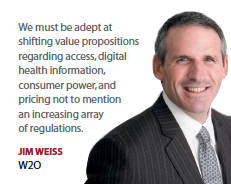 to help incrementally improve efficiency. Yet there are so many fundamental technology choices and structures that need addressing before we explore the full potential of AI. As an important example, eCOA is by comparison a simple technology that transforms the quality and reliability of patient data captured on paper, which can certainly be fed into an AI platform. However, after two decades, eCOA adoption still sits, somewhat generously, at 15% to 20% adoption. Then there are emerging technologies like eConsent and patient engagement, which are barely out of their infancy. What makes us think we are ready for AI? We want to apply solutions like machine learning when and where they make sense. A the same time, we still have a long way to go with where we are at now, with plenty of room to improve adoption of solutions that can have a dramatic and profound impact on the patient experience, and patient data, in clinical research worldwide.
to help incrementally improve efficiency. Yet there are so many fundamental technology choices and structures that need addressing before we explore the full potential of AI. As an important example, eCOA is by comparison a simple technology that transforms the quality and reliability of patient data captured on paper, which can certainly be fed into an AI platform. However, after two decades, eCOA adoption still sits, somewhat generously, at 15% to 20% adoption. Then there are emerging technologies like eConsent and patient engagement, which are barely out of their infancy. What makes us think we are ready for AI? We want to apply solutions like machine learning when and where they make sense. A the same time, we still have a long way to go with where we are at now, with plenty of room to improve adoption of solutions that can have a dramatic and profound impact on the patient experience, and patient data, in clinical research worldwide.
Dr. Michael Bozik
Knopp Biosciences
We have employed machine-learning tools to extract non-obvious correlations and other valuable insights from large datasets. Computer-aided drug discovery (CADD) is a core tool we apply to exploit the full value of our pharmacology platform. While AI and other predictive tools can inform decision-making and study design in biomedical research, they cannot substitute for ultimately conducting clinical trials and other real-world experiments.
Suresh Katta
Saama Technologies
As technology providers, we bring value to our customers by responsibly and practically enabling the use of AI: clearly defined outcomes. When technical innovation is not tied to operational imperatives, it becomes an academic exercise. Another challenge is access to curated data corpus.(PV)
~~~~~~~~~~~~~~~~~~~~~~~~~
Five Trademarks of an Agile Organization
According to McKinsey, agile organizations embody the following novel and highly disciplined set of practices:
Agile organizations have a North Star embodied across the organization. Guided by this North Star, they reimagine both who they create value for and how. They are obsessively customer focused, and they are committed to creating value with and for a wide range of other stakeholders, including employees, investors, partners, and communities.
Agile organizations work through a network of small, empowered teams. They maintain a stable backbone structure but replace much of the remaining traditional hierarchy with a flexible, scalable network of teams.
Agile organizations use rapid decision and learning cycles. They work in rapid cycles of thinking and doing, breaking work down into small packages; executing in short, focused bursts; and frequently recalibrating based on carefully tracked goals and metrics.
Agile organizations have a dynamic people model that ignites passion. They put 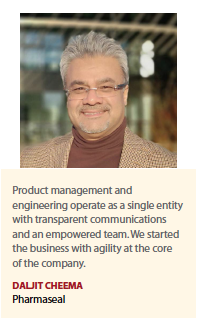 people at the heart of culture and leadership, engaging and empowering everyone in the organization to create value quickly, collaboratively, and effectively.
people at the heart of culture and leadership, engaging and empowering everyone in the organization to create value quickly, collaboratively, and effectively.
Agile organizations use next-generation-enabling technology. They radically rethink their underlying technologies to support quick iterations, higher deployment velocity, and flexibility through new practices and tools.
~~~~~~~~~~~~~~~~~~~~~~~~~
Agile Adoption
For big pharma companies, finding new blockbuster drugs is becoming harder and more expensive and the challenge shows no sign of easing in 2019. Small and mid-tier companies are responsible for 63% of new products brought to market since 2013, according to HBM Partners, making 2019 the year for big pharma to add more innovation to its business model.
JLL’s life-sciences experts anticipate that big pharma will adopt agile real estate strategies and more entrepreneurial approaches to reinvent R&D and compete with smaller enterprises that are doubling down on product innovation and delivery.
“Without productive, efficient R&D processes that deliver strong revenue to drive reinvestment into continuing innovation, the business model falls apart," says Roger Humphrey, executive managing director and leader of JLL’s life-sciences group. “In 2019, big pharma will focus on solving the R&D conundrum through investing in startups, buying pipelines, bringing incubator spaces into the market, creating flexible lab spaces, embarking on joint ventures, and more."
~~~~~~~~~~~~~~~~~~~~~~~~~
Four Trends To Watch In 2019
1. Venture capital will continue to flood biopharmaceutical innovators. The worldwide prescription drug market is growing at 6.5% annually and is expected to reach $1.06 trillion by 2022. To capture this market opportunity, major biopharma companies are creating their own VC funds and partnering with startups or licensing technology to fuel their drug pipelines. Many are also outsourcing R&D while reducing their in-house product development efforts.
2. Incubator labs will share the cost burden for drug discovery. With real estate costs at all-time highs and availability at all-time lows, life-sciences companies — along with real estate owners and investors — are finding new ways to engage with the up-and-comers. Life-sciences incubators are popping up across the United States and becoming a critical part of the ecosystem. Massachusetts alone is home to more than two dozen incubators.
For young companies looking to grow in the top life-sciences clusters, incubators are filling a critical facilities gap. Part investment fund, part accelerator, incubators nurture the growth of early-stage life-sciences companies by providing turnkey laboratory and office space, entrepreneurial support, strategic programming, and access to capital.
Some incubator concepts are in-house. For example, early adopter Johnson & Johnson established its JLABS incubator concept five years ago and now operates incubators in 11 locations around the world. JLABS space options range from a five-foot bench to a 5,000-square-foot wet research lab outfitted with the latest equipment.
3. Flex space will unlock innovation and savings in R&D operations desperate for a facelift. The average return on R&D investments among large biopharma firms has declined from 10.1% in 2010 to 3.2% in 2017, creating pressure to shorten and invigorate the product lifecycle. Flexible space and access to talent are the keys to agile R&D, according to JLL’s journey to the next gen lab report.
4. High-risk, high-reward mid-tier pharmaceutical companies will focus on flexibility for non-core services. In 2017, mid-sized and smaller biopharma companies received a record number of 23 new drug approvals — making mid-tier companies the industry darling for investors. So what is their winning strategy? Focus and flexibility enables them to respond quickly to market changes and stay concentrated on their core business of bringing new products to market quickly.
“In 2019, we expect mid-tier companies to stay focused on the product business that has brought them success in the past, while looking to trusted partners for non-core services, including real estate services, so they can prioritize innovation and accelerate agility," Mr. Humphrey says.
~~~~~~~~~~~~~~~~~~~~~~~~~
Opportunities on the Horizon
We asked our C-suite executives to identify the biggest near-term opportunities they envision as an agile organization.
Dr. Michael Bozik
Knopp Biosciences
The transformation of healthcare through the introduction of individual biomolecular disease fingerprinting leading to innovative treatments for conditions previously considered hopeless.
Joan Bradley, Pharm.D.
JB Ashtin
Relative to medical communications and healthcare provider and patient engagement, we have an opportunity to expand our educational reach via new technologies. The ability to gain insights from and share impactful, perspective-changing, outcome-shifting educational experiences with providers and patients without regard to their locations is an opportunity we look forward to grabbing as we head into our 20th year in business.
Daljit Cheema
Pharmaseal
Support the many small- to medium-sized organizations that are developing innovative medical products for health and well-being by providing affordable unified enterprise management systems for clinical trials.
Alex Huang
Quellthera
Completing high-profile Phase II trials is pivotal.
Patrick Hughes
CluePoints
The regulatory endorsement of new working practices that are directly connected to our solutions means that the industry as a whole is beginning a journey of change. Rarely do industry regulations give sponsors the opportunity to make ground-breaking changes that will ensure greater efficiencies and cost-savings but ICH E6 R2 has done exactly that and sponsors and CROs alike are preparing themselves for the paradigm shift required to effect the change.
Dr. Patrick Lu
Sirnaomics
We are building an innovative drug discovery and development platform, and making novel RNAi therapeutic products for patient’s unmet needs.
Nathan Lucht
LeveragePoint Media
Specialty pharma customers are always in the pharmacy and being able to educate them while in the healthcare mindset moment will help them get information on specialty drugs that will help them with their ailment.
Alistair MacDonald
Syneos Health
As we move the industry to product development, the priority is to provide an end-to-end clinical development and product commercialization platform. Products that work well in the real world, with good access for patients, and a strong reimbursement profile are the future.
Mike Nolte
CRF Bracket
There is a whole world of clinical information that basically doesn’t get used in clinical research. For example, with the adoption of EHRs and data sets built up over years, it 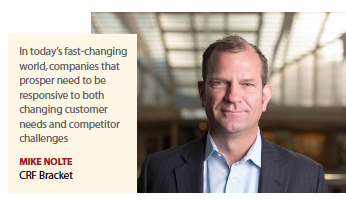 is logical to believe there is insight that can come from such records that could accelerate the process in clinical research and give greater insight in how to think about a drug’s efficacy and the patient context. Limiting this, however, are regulatory and privacy barriers. On a more local level, adopting technologies enterprise-wide that improve the reliability of patient data and provide empathy for the patient experience is an opportunity ready and waiting to be taken advantage of by life-sciences companies today. Tapping into these tremendous resources in a responsible, ethical, and thoughtful way has the power to transform how clinical research is conducted globally.
is logical to believe there is insight that can come from such records that could accelerate the process in clinical research and give greater insight in how to think about a drug’s efficacy and the patient context. Limiting this, however, are regulatory and privacy barriers. On a more local level, adopting technologies enterprise-wide that improve the reliability of patient data and provide empathy for the patient experience is an opportunity ready and waiting to be taken advantage of by life-sciences companies today. Tapping into these tremendous resources in a responsible, ethical, and thoughtful way has the power to transform how clinical research is conducted globally.
Alexis Peyroles
OSE Immunotherapeutics
Partnerships and licensing deals with pharmaceutical industry leaders, clinical organizations, and academic laboratories are big business opportunities. As part of our long-term strategy we find sharing expertise to help ensure that new therapies are delivered to patients as fast as possible is very valuable. We have demonstrated an expertise in identifying and developing best- or first-in-class compounds. For some compounds, we have strategically engaged in partnerships with major players in industry to help with late-stage clinical testing and commercialization, more their areas of expertise, ensuring that they have the best chance to meet their full potential.
Jim Weiss
W2O
Expanding our footprint in the evolving healthcare industry unfolding today is a goal. Digital is the change agent of healthcare. Our mission has never been more relevant than it is today.
~~~~~~~~~~~~~~~~~~~~~~~~~
Thought Leaders
Carla Balch
CEO
TransMed Systems
TransMed Systems provids technology, insights, and expertise to help harness the power of knowledge to dramatically improve the process of developing, identifying, and matching eligible patients to clinical trials.
Michael Bozik, M.D.
President and CEO
Knopp Biosciences LLC
@knoppbio
Knopp Biosciences is a privately held drug discovery and development company focused on delivering breakthrough treatments for inflammatory and neurological diseases with a high unmet need.
Joan Bradley, Pharm.D.
President & CEO
JB Ashtin
JB Ashtin is a certified WBENC- owned medical communication & pharmaceutical marketing company.
Daljit Cheema
CEO
Pharmaseal International Ltd.
Pharmaseal International Ltd. applies industry expertise, innovative thinking, and advanced automation to build and operate an integrated enterprise platform that allows biopharmaceutical and medical device companies to manage all of their clinical trials effectively.
Joe Depinto
President
Cardinal Health Specialty Solutions
Cardinal Health Specialty Solutions —with more than 20 years of experience in third-party logistics (3PL) — has expertise in getting products to market where, when, and how customers need to.
Jean Drouin
Founder and CEO
Clarify Health Solutions
Clarify Health Solutions is a provider of comprehensive digital solutions to optimize care.
Sonja Foster-Storch
President, Advertising
Syneos Health Communications
Syneos Health Communications is a communications company on the frontlines of healthcare, with a clear view into the everyday complexities of life and health.
Alex Huang
CEO and Founder
Quellthera Inc.
Quellthera Inc. addresses the growing threat of antibiotic resistant disease with EpiQuell, a novel concept in anti–pathogenic therapies that harnesses the plant kingdom’s evolution-proven ability to control bacterial behavior.
Patrick Hughes
Chief Commercial Officer
CluePoints
CluePoints is a risk-based monitoring and central statistical monitoring solution that has been designed and perfected over the last 20 years and now ensures compliance with the obligations of ICH E6 R2 for sponsors and CROs alike.
Mir Imran
CEO
Rani Therapeutics
Rani Therapeutics is a developer of oral biotherapeutics technologies for the oral delivery of large drug molecules that include peptides, proteins, and antibodies.
Suresh Katta
Founder and CEO
Saama Technologies Inc.
Saama Technologies Inc. is a unified, AI-driven clinical data analytics platform that seamlessly integrates, curates, and animates unlimited sources of structured, unstructured, and real-world data to deliver actionable insights across all therapeutic areas.
Patrick Lu, Ph.D.
President and CEO
Sirnaomics Inc.
Sirnaomics Inc. is a biopharmaceutical company discovering and developing novel targeted therapeutics for critical human diseases by using RNA interference (RNAi) technology.
Nathan Lucht
CEO
LeveragePoint Media
LeveragePoint Media provides in-store advertising services and patient acquisition and adherence programs for healthcare and consumer packaged goods companies.
Alistair MacDonald
CEO
Syneos Health
Syneos Health is a fully integrated biopharmaceutical solutions organization, which includes a contract research organization (CRO) and contract commercial organization (CCO), is purpose-built to accelerate customer performance to address modern market realities.
Mike Nolte
CEO
CRF Bracket
CRF Bracket provides drug development companies a unique technology and service partner for clinical research.
Alexis Peyroles
CEO
OSE Immunotherapeutics
OSE Immunotherapeutics is a clinical-stage biotechnology company focused on developing and partnering therapies to control the immune system for immuno-oncology and autoimmmune diseases.
Anders Rabbe
CEO
Isofol Medical
Isofol Medical has the objective to improve the outlook for the majority of cancer patients undergoing chemotherapy treatments.
Julie Ross
President
Advanced Clinical
Advanced Clinical is a clinical research services company providing CRO, FSP, strategic resourcing, and consulting services.
Jim Weiss
CEO and Founder
W2O
W2O is a healthcare-focused marketing communications firm driven by marketing science to give brands an unfair advantage.
Sherri Wilkins
President
Carling Communications
Carling Communications is a marketing and communications agency.
~~~~~~~~~~~~~~~~~~~~~~~~~
Quotes
Agile organizations should theoretically be able to innovate and adapt more successfully by more rapidly recombining their knowledge and resources to create new solutions as the needs of their customers evolve.
Jean Drouin
Clarify Health Solutions
On the road to success, failure is a constant companion and success is an occasional visitor.
Mir Imran
Rani Therapeutics
Our North Star is “one source of truth." The greatest utility for information is to serve all stakeholders without spin so decisions are made based on veracity.
Carla Balch
TransMed Systems
The demand for new and novel approaches is constant, our market changes constantly and without our ability to move quickly we would not survive.
Alistair MacDonald
Syneos Health
As we all know, the world is going digital and we are no different. Data is becoming the new currency and we are building our business to capitalize on that.
Nathan Lucht
LeveragePoint Media
As CEO, it is my responsibility to continue to promote a value-driven culture and to 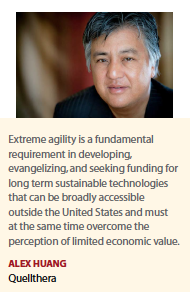 manage a multi-disciplinary, cross-functional team, especially now as we transition into a late-stage clinical development company.
manage a multi-disciplinary, cross-functional team, especially now as we transition into a late-stage clinical development company.
Anders Rabbe
Isofol Medical
Our vision is to bend the time and cost curve for drug development cycles by unleashing the power of AI-enabled data and analytics.
Suresh Katta
Saama Technologies
We are building an innovative drug discovery and development platform, and making novel RNAi therapeutic products for patients’ unmet needs.
Dr. Patrick Lu
Sirnaomics
Sometimes knowing the purpose and envisioned outcome and how it will indirectly improve patient care is all that is needed to motivate and inspire.
Joan Bradley
JB Ashtin
The market absolutely demands that we continue to make our organizational structures more sophisticated.
Sherri Wilkins
Carling Communications
The dynamic interaction of market forces demands high agility even of a pre-revenue biotechnology company such as ours.
Dr. Michael Bozik
Knopp Biosciences
AI is becoming a crucial accelerator to the life-sciences industry throughout the product lifecycle, bringing efficiency in both time and money.
Sonja Foster-Storch
Syneos Health Communications
The clinical research industry is undergoing rapid change driven by AI, machine learning, blockchain, wearables, and virtual trials enabled by newer technology, all of which mandate agility.
Julie Ross
Advanced Clinical
Empowering teams to act independently streamlines the decision-making process, 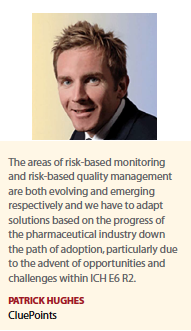 especially in situations where either timing is key or where the decision does not affect the whole organization.
especially in situations where either timing is key or where the decision does not affect the whole organization.
Alexis Peyroles
OSE Immunotherapeutics
We must be adept at shifting value propositions regarding access, digital health information, consumer power, and pricing not to mention an increasing array
of regulations.
Jim Weiss
W2O
Extreme agility is a fundamental requirement in developing, evangelizing, and seeking funding for long term sustainable technologies that can be broadly accessible outside the United States and must at the same time overcome the perception of limited economic value.
Alex Huang
Quellthera
The areas of risk-based monitoring and risk-based quality management are both evolving and emerging respectively and we have to adapt solutions based on the progress of the pharmaceutical industry down the path of adoption, particularly due to the advent of opportunities and challenges within ICH E6 R2.
Patrick Hughes
CluePoints
In today’s fast-changing world, companies that prosper need to be responsive to both changing customer needs and competitor challenges.
Mike Nolte
CRF Bracket
Product management and engineering operate as a single entity with transparent communications and an empowered team. We started the business with agility at the core of the company.
Daljit Cheema
Pharmaseal
















